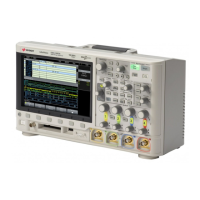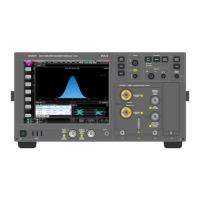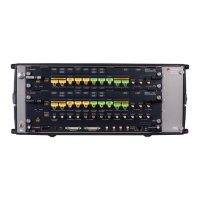I2C/SPI Triggering and Serial Decode 28
Keysight InfiniiVision 3000T X-Series Oscilloscopes User's Guide 441
5 If you have set the oscilloscope to trigger on an EEPROM Data Read condition:
Press the Data is softkey to set the oscilloscope to trigger when data is = (equal
to), ≠ (not equal to), < (less than), or > (greater than) the data value set in the
Data softkey.
The oscilloscope will trigger on the clock edge for the Ack bit after the trigger
event is found. This data byte does not need to occur directly after the control
byte. The oscilloscope will trigger on any data byte that meets the criteria
defined by the Data is and Data softkeys during a current address read or a
random read or a sequential read cycle.
6 If you have set the oscilloscope to trigger on a 7-bit address read or write frame
condition or a 10-bit write frame condition:
a Press the Address softkey and turn the Entry knob to select the 7-bit or
10-bit device address.
You can select from an address range of 0x00 to 0x7F (7-bit) or 0x3FF
(10-bit) hexadecimal. When triggering on a read/write frame, the
oscilloscope will trigger after the start, address, read/write, acknowledge,
and data events occur.
If don't care is selected (0xXX or 0xXXX) for the address, the address will be
ignored. The trigger will always occur on the 17th clock for 7-bit addressing
or 26th clock for 10-bit addressing.
b Press the Data value softkey and turn the Entry knob to select the 8-bit data
pattern on which to trigger.
You can select a data value in the range of 0x00 to 0xFF (hexadecimal). The
oscilloscope will trigger after the start, address, read/write, acknowledge,
and data events occur.
If don't care (0xXX) is selected for data, the data will be ignored. The trigger
will always occur on the 17th clock for 7-bit addressing or 26th clock for
10-bit addressing.
c If you have selected a three-byte trigger, press the Data2 value softkey and
turn the Entry knob to select the 8-bit data pattern on which to trigger.
To display I2C serial decode, see “I2C Serial Decode" on page 442.

